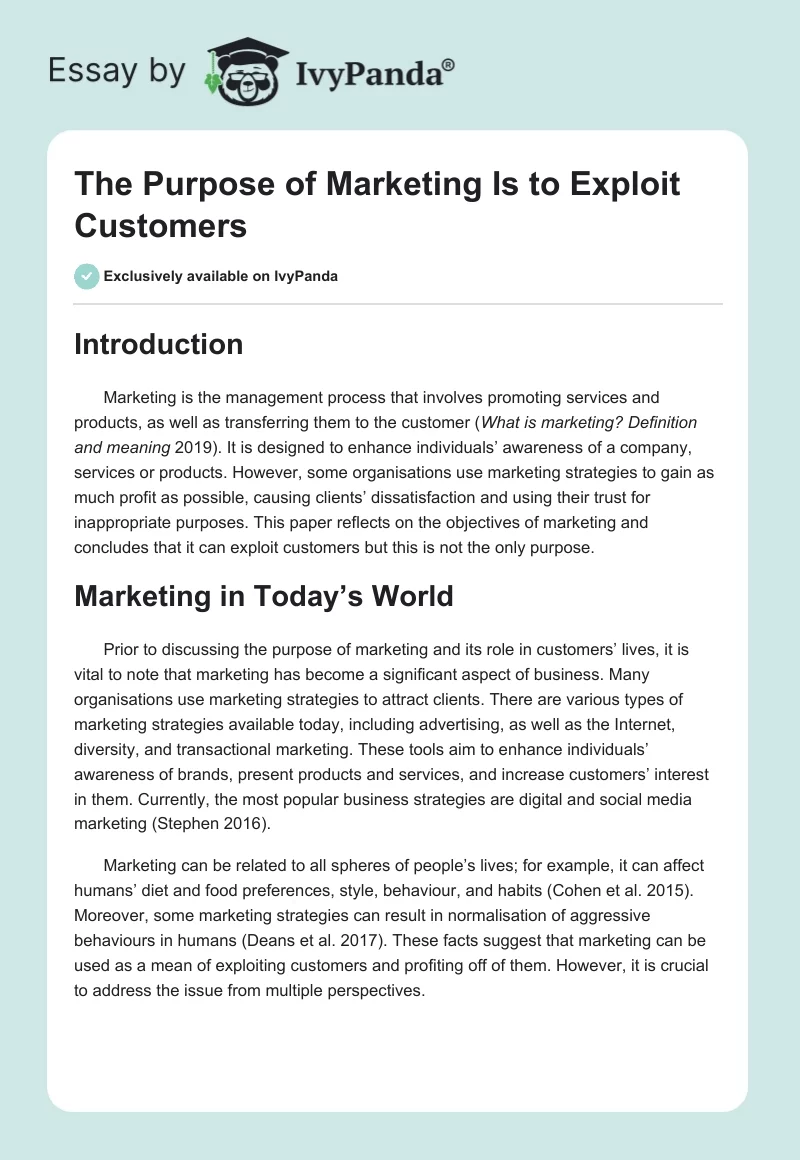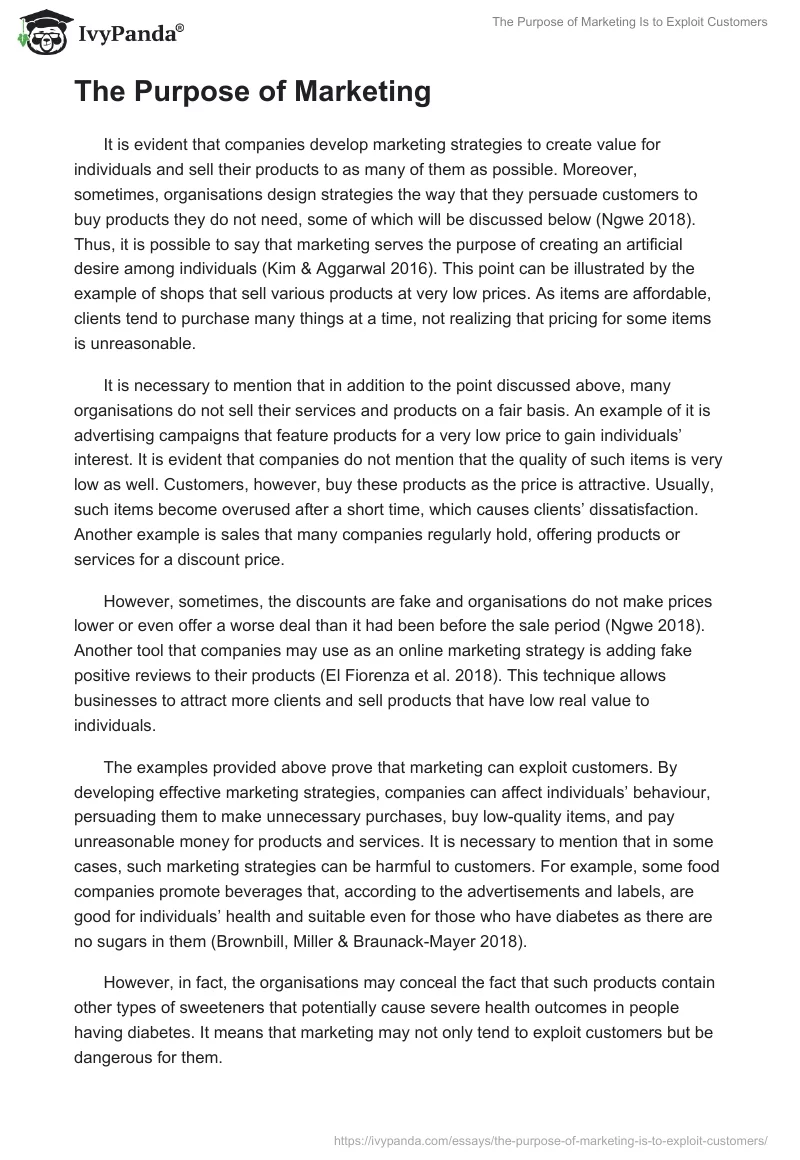Introduction
Marketing is the management process that involves promoting services and products, as well as transferring them to the customer (What is marketing? Definition and meaning 2019). It is designed to enhance individuals’ awareness of a company, services or products. However, some organisations use marketing strategies to gain as much profit as possible, causing clients’ dissatisfaction and using their trust for inappropriate purposes. This paper reflects on the objectives of marketing and concludes that it can exploit customers but this is not the only purpose.
Marketing in Today’s World
Prior to discussing the purpose of marketing and its role in customers’ lives, it is vital to note that marketing has become a significant aspect of business. Many organisations use marketing strategies to attract clients. There are various types of marketing strategies available today, including advertising, as well as the Internet, diversity, and transactional marketing. These tools aim to enhance individuals’ awareness of brands, present products and services, and increase customers’ interest in them. Currently, the most popular business strategies are digital and social media marketing (Stephen 2016).
Marketing can be related to all spheres of people’s lives; for example, it can affect humans’ diet and food preferences, style, behaviour, and habits (Cohen et al. 2015). Moreover, some marketing strategies can result in normalisation of aggressive behaviours in humans (Deans et al. 2017). These facts suggest that marketing can be used as a mean of exploiting customers and profiting off of them. However, it is crucial to address the issue from multiple perspectives.
The Purpose of Marketing
It is evident that companies develop marketing strategies to create value for individuals and sell their products to as many of them as possible. Moreover, sometimes, organisations design strategies the way that they persuade customers to buy products they do not need, some of which will be discussed below (Ngwe 2018). Thus, it is possible to say that marketing serves the purpose of creating an artificial desire among individuals (Kim & Aggarwal 2016). This point can be illustrated by the example of shops that sell various products at very low prices. As items are affordable, clients tend to purchase many things at a time, not realizing that pricing for some items is unreasonable.
It is necessary to mention that in addition to the point discussed above, many organisations do not sell their services and products on a fair basis. An example of it is advertising campaigns that feature products for a very low price to gain individuals’ interest. It is evident that companies do not mention that the quality of such items is very low as well. Customers, however, buy these products as the price is attractive. Usually, such items become overused after a short time, which causes clients’ dissatisfaction. Another example is sales that many companies regularly hold, offering products or services for a discount price.
However, sometimes, the discounts are fake and organisations do not make prices lower or even offer a worse deal than it had been before the sale period (Ngwe 2018). Another tool that companies may use as an online marketing strategy is adding fake positive reviews to their products (El Fiorenza et al. 2018). This technique allows businesses to attract more clients and sell products that have low real value to individuals.
The examples provided above prove that marketing can exploit customers. By developing effective marketing strategies, companies can affect individuals’ behaviour, persuading them to make unnecessary purchases, buy low-quality items, and pay unreasonable money for products and services. It is necessary to mention that in some cases, such marketing strategies can be harmful to customers. For example, some food companies promote beverages that, according to the advertisements and labels, are good for individuals’ health and suitable even for those who have diabetes as there are no sugars in them (Brownbill, Miller & Braunack-Mayer 2018).
However, in fact, the organisations may conceal the fact that such products contain other types of sweeteners that potentially cause severe health outcomes in people having diabetes. It means that marketing may not only tend to exploit customers but be dangerous for them.
Another Side of Marketing
It is necessary to mention that marketing can be beneficial for its target audience too. For example, there are social marketing campaigns aimed to help individuals. Ashwood et al. (2017) describe such a campaign, the purpose of which is to eliminate stigma and discrimination associated with mental illnesses. This marketing strategy is similar to those described above, as it also has a target audience and its goal is to attract funds. However, the campaign does not cause harm to individuals as there are no organisations that gain profit from it; on the contrary, it is beneficial for people living with mental disorders.
Nevertheless, marketing is usually associated with business and trade, but even in these spheres does not always exploit customers. For example, various organisations use the principle of fairness in their business strategies. Bhattacharya (2016) remarks that currently, many businesses have started to take responsibility for their actions, be sustainable, and treat both their customers and their employees with respect. One of the goals of such organisations may be gaining profit, but they strive to provide high-quality products and services in exchange for it. In this case, it is impossible to say that the purpose of their marketing strategies is harmful or unfair. Thus, although many companies may exploit their customers, it is not the primary goal of marketing.
Summary and Conclusion
The paper shows various examples of how marketing can exploit clients and persuade them to purchase unnecessary items and pay unreasonable prices. It is evident that, from this perspective, the marketing strategies of many companies can be unfair to individuals and can harm them. Currently, organisations use various techniques aimed to gain profit and obtain the customer’s interest, including the establishment of fake sales, excessively low prices, and presenting false facts about their products. However, not all types of marketing serve the purpose of exploiting clients. There are marketing campaigns that aim to support those in need and work on social issues. Thus, it is possible to say that many organisations use marketing for inappropriate purposes, but the exploitation of customers is not its goal.
Reference List
Ashwood, JS, Briscombe, B, Collins, RL, Wong, EC, Eberhart, NK, Cerully, J, May, L, Roth, B & Burnam, MA 2017,‘Investment in social marketing campaign to reduce stigma and discrimination associated with mental illness yields positive economic benefits to California’, Rand Health Quarterly, vol. 6, no. 2. Web.
Bhattacharya, CB 2016, ‘Responsible marketing: doing well by doing good’, Marketing Intelligence Review, vol. 8, no. 1, pp. 8-17.
Brownbill, AL, Miller, CL & Braunack-Mayer, AJ 2018, ‘Industry use of ‘better-for-you’ features on labels of sugar-containing beverages’, Public Health Nutrition, vol. 21, no. 18, pp. 3335-3343.
Cohen, DA, Collins, R, Hunter, G, Ghosh-Dastidar, B & Dubowitz, T 2015,‘Store impulse marketing strategies and body mass index’, American Journal of Public Health, vol. 105, no. 7, pp. 1446-1452.
Deans, EG, Thomas, SL., Derevensky, J & Daube, M 2017, ‘The influence of marketing on the sports betting attitudes and consumption behaviours of young men: implications for harm reduction and prevention strategies’, Harm Reduction Journal, vol. 14, no. 1. Web.
El Fiorenza, C, Kashyap, AS, Chauhan, K, Mokaria, K & Chandra, A 2018,‘Fake product review monitoring and removal for genuine online reviews’, Journal of Network Communications and Emerging Technologies, vol. 8, no. 4, pp.378-381.
Kim, CS & Aggarwal, P 2016, ‘The customer is king: culture-based unintended consequences of modern marketing’, Journal of Consumer Marketing, vol. 33, no. 3, pp. 193-201.
Ngwe, D 2018, Fake discounts drive real revenues in retail. Web.
Stephen, AT 2016, ‘The role of digital and social media marketing in consumer behavior’, Current Opinion in Psychology, vol. 10, pp. 17-21.
What is marketing? Definition and meaning 2019. Web.


